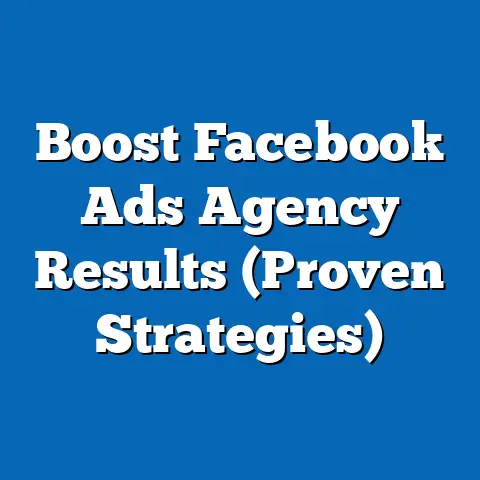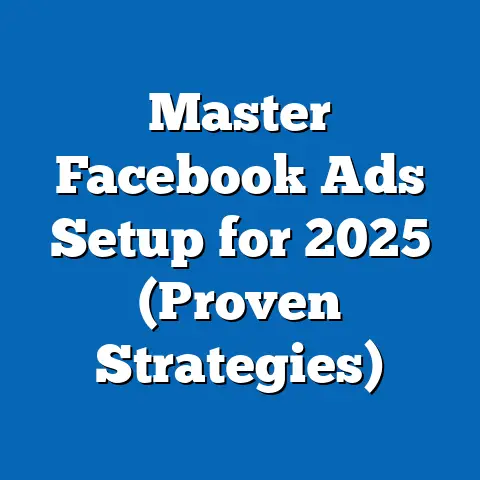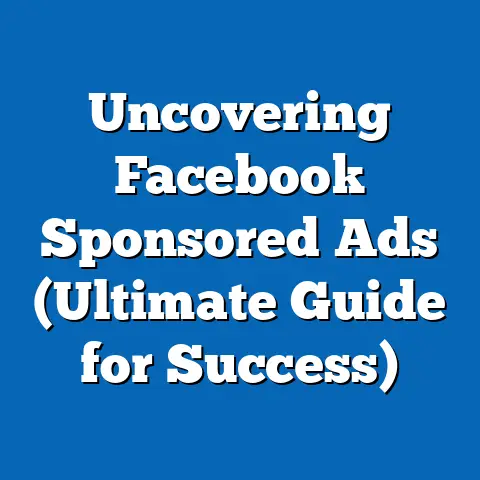Maximize Search Ads on Facebook (Unlock Proven Strategies)
In the fast-paced world of digital marketing, first impressions are everything. Think about it: how many times do you mindlessly scroll through your Facebook feed, barely registering the endless stream of posts, memes, and updates? As a digital marketer, I know that users make split-second decisions on what to engage with, and if your ad doesn’t immediately capture their attention, it’s lost in the digital ether. This is where the strategic use of Facebook search ads comes into play.
Facebook search ads offer a unique opportunity to combine the power of targeted advertising with the vast reach of social media. Unlike traditional display ads that rely on visual appeal and interruptive placement, search ads target users actively seeking specific information or products. When leveraged effectively, these ads can significantly increase visibility, drive higher conversion rates, and improve your return on ad spend (ROAS).
Understanding Facebook Search Ads
So, what exactly are search ads on Facebook, and how do they differ from the display ads we’re all so accustomed to seeing? The core difference lies in intent. Display ads are often served to users based on their interests, demographics, or browsing history, regardless of whether they’re actively looking for something. Search ads, on the other hand, appear when users actively search for specific keywords or phrases within the Facebook search bar.
Think of it this way: a display ad might show you a promotion for running shoes because you’ve previously visited a sports website. A search ad for running shoes would appear when you type “best running shoes for marathon” into the Facebook search bar. This intent-based targeting makes search ads incredibly powerful.
How Facebook Search Ads Work
The mechanics of Facebook search ads within the platform are relatively straightforward:
- Keyword Selection: You, as the advertiser, choose relevant keywords that align with your product or service.
- Ad Creation: You craft compelling ad copy and select visuals that will appear when users search for those keywords.
- Bidding: You bid on the keywords you’ve chosen, competing with other advertisers for ad placement.
- Placement: When a user searches for a keyword you’ve bid on, your ad may appear at the top of the search results page.
- Analytics: You track the performance of your ad, analyzing metrics like impressions, clicks, and conversions to optimize your campaign.
The algorithm that governs ad placement considers factors like your bid amount, the quality of your ad, and the relevance of your ad to the user’s search query.
Who Benefits Most from Facebook Search Ads?
While any business can potentially benefit from Facebook search ads, certain industries and business types tend to see the most success. These include:
- Local Businesses: Restaurants, salons, and other local service providers can use search ads to target users searching for nearby businesses. For example, a pizza place could target users searching for “pizza near me.”
- E-commerce Businesses: Online retailers can use search ads to target users searching for specific products. For example, a clothing store could target users searching for “summer dresses.”
- Service Providers: Professionals like lawyers, accountants, and consultants can use search ads to target users searching for their services. For example, a lawyer could target users searching for “divorce attorney.”
- Events and Entertainment: Concerts, festivals, and other events can use search ads to target users searching for local events or specific performers.
In my experience, businesses that offer a clear solution to a specific problem or cater to a niche audience often see the best results with Facebook search ads.
Key Metrics to Track
Measuring the success of your Facebook search ads is crucial for optimizing your campaigns and maximizing your ROI. Here are some key metrics I always keep an eye on:
- Impressions: The number of times your ad is displayed to users.
- Click-Through Rate (CTR): The percentage of users who click on your ad after seeing it. A high CTR indicates that your ad is relevant and engaging.
- Cost-Per-Click (CPC): The amount you pay each time a user clicks on your ad. A low CPC means you’re getting good value for your advertising spend.
- Conversion Rate: The percentage of users who complete a desired action (e.g., making a purchase, filling out a form) after clicking on your ad.
- Return on Ad Spend (ROAS): The amount of revenue you generate for every dollar you spend on advertising.
Key Takeaway: Facebook search ads offer a powerful way to reach users actively seeking specific information or products. By understanding how these ads work and tracking the right metrics, you can significantly improve your advertising performance.
Crafting Compelling Ad Copy
In the realm of Facebook search ads, your ad copy is your digital handshake. It’s the first, and often only, chance you have to make a positive impression and convince users to click on your ad. I’ve seen countless campaigns fail simply because the ad copy was bland, irrelevant, or uninspiring.
Key Components of Effective Ad Copy
Compelling ad copy isn’t just about writing pretty words; it’s about strategically crafting a message that resonates with your target audience and motivates them to take action. Here are the key components I focus on when writing ad copy:
- Clarity: Your ad copy should be easy to understand and clearly communicate the value proposition of your product or service. Avoid jargon or overly technical language.
- Relevance: Your ad copy should be directly relevant to the keywords users are searching for. If someone searches for “best Italian restaurant near me,” your ad copy should immediately address that need.
- Urgency: Create a sense of urgency to encourage users to click on your ad now. Use phrases like “Limited Time Offer,” “Sale Ends Soon,” or “Book Now.”
- Call to Action (CTA): Tell users exactly what you want them to do. Use clear and concise CTAs like “Shop Now,” “Learn More,” “Get a Free Quote,” or “Sign Up Today.”
Examples of Successful Ad Copy
Let’s look at a couple of examples of successful Facebook search ads with compelling copy:
Example 1: Local Plumber
- Headline: Emergency Plumbing Services – 24/7 Availability
- Description: Leaky faucet? Burst pipe? We’re your local plumbing experts, available 24/7 for all your emergency plumbing needs. Fast response times and affordable rates. Call now for a free quote!
- CTA: Call Now
Why it works: This ad copy is clear, relevant, and urgent. It directly addresses the needs of users searching for emergency plumbing services and includes a clear CTA.
Example 2: Online Language Learning Platform
- Headline: Learn Spanish Online – Start Speaking Today!
- Description: Unlock fluency with our interactive online Spanish courses. Personalized lessons, expert instructors, and flexible scheduling. Try a free trial and start speaking Spanish today!
- CTA: Start Free Trial
Why it works: This ad copy highlights the benefits of the platform, creates a sense of urgency with the “Start Speaking Today!” headline, and includes a compelling CTA.
A/B Testing Your Ad Copy
The best way to determine what ad copy resonates best with your target audience is to A/B test different variations. Facebook Ads Manager makes it easy to create multiple ad variations and track their performance. I typically test the following elements:
- Headlines: Try different headlines to see which ones generate the most clicks.
- Descriptions: Experiment with different descriptions to highlight different benefits of your product or service.
- CTAs: Test different CTAs to see which ones drive the most conversions.
Remember to only test one element at a time to accurately measure the impact of each change.
Key Takeaway: Compelling ad copy is essential for driving clicks and conversions on Facebook search ads. By focusing on clarity, relevance, urgency, and a clear CTA, you can create ads that grab attention and motivate users to take action.
Utilizing Targeting Options
One of the most powerful features of Facebook advertising is its robust targeting capabilities. I’ve found that even the most brilliantly crafted ad copy will fall flat if it’s not shown to the right audience. Facebook allows you to target users based on a wide range of factors, ensuring that your ads reach the people who are most likely to be interested in your product or service.
Targeting Options Available
Here are some of the key targeting options available on Facebook for search ads:
- Demographic Targeting: Target users based on age, gender, location, education, relationship status, and other demographic factors.
- Interest Targeting: Target users based on their interests, hobbies, and the pages they’ve liked on Facebook.
- Behavior Targeting: Target users based on their online behavior, such as their purchase history, device usage, and travel habits.
- Lookalike Audiences: Create audiences that are similar to your existing customers or website visitors.
- Custom Audiences: Upload your own customer data (e.g., email addresses, phone numbers) to create targeted audiences.
Identifying and Segmenting Your Target Audience
The key to effective targeting is to understand your target audience inside and out. I always start by asking myself these questions:
- Who are my ideal customers?
- What are their demographics?
- What are their interests?
- What are their pain points?
- What are their online behaviors?
Once you have a clear understanding of your target audience, you can use Facebook’s targeting options to reach them effectively.
Using Facebook’s Audience Insights Tool
Facebook’s Audience Insights tool is an invaluable resource for refining your targeting strategies. This tool allows you to analyze the demographics, interests, and behaviors of your target audience, providing valuable insights that can inform your ad campaigns.
For example, you can use Audience Insights to:
- Identify the top interests of your target audience.
- Discover the pages they’ve liked on Facebook.
- Learn about their purchasing habits.
- Understand their device usage.
Case Studies: Advanced Targeting in Action
Let’s look at a couple of real-world examples of brands that have successfully used advanced targeting options to improve their search ad performance:
Case Study 1: Subscription Box Service
A subscription box service targeting pet owners used lookalike audiences to expand their reach. They created a lookalike audience based on their existing customer base and saw a 30% increase in conversions.
Case Study 2: Online Education Platform
An online education platform targeting working professionals used custom audiences to re-engage website visitors who hadn’t completed a purchase. They uploaded their website visitor data to Facebook and created a custom audience, resulting in a 20% increase in sales.
Key Takeaway: Targeting is crucial for the success of your Facebook search ads. By understanding your target audience and using Facebook’s robust targeting options, you can ensure that your ads reach the right people and drive the best possible results.
Visual Elements and Design
While compelling ad copy is essential, the visual elements of your Facebook search ads play a crucial role in capturing attention and driving engagement. In a visually saturated environment like Facebook, your ad needs to stand out from the crowd and immediately grab the user’s eye.
The Role of Visuals in Search Ads
Visuals, whether images or videos, serve several important functions in Facebook search ads:
- Attention-Grabbing: A striking visual can instantly capture the user’s attention and stop them from scrolling.
- Brand Communication: Visuals can communicate your brand message and personality effectively.
- Contextual Relevance: Visuals can provide context and relevance to your ad copy, helping users understand what you’re offering.
- Emotional Connection: Visuals can evoke emotions and create a connection with your target audience.
Guidelines for Selecting Images and Videos
Choosing the right visuals for your Facebook search ads is crucial for maximizing their impact. Here are some guidelines I follow:
- Relevance: Ensure that your visuals are directly relevant to your ad copy and target audience.
- Quality: Use high-quality images and videos that are visually appealing and professional.
- Brand Alignment: Choose visuals that align with your brand’s identity and messaging.
- Emotional Appeal: Select visuals that evoke positive emotions and create a connection with your target audience.
- Mobile Optimization: Ensure that your visuals are optimized for mobile devices, as most Facebook users access the platform on their smartphones.
Best Practices for Visual Design
In addition to selecting the right images and videos, it’s important to design your ads in a way that enhances user engagement. Here are some best practices I recommend:
- Use Clear and Concise Text: If you include text in your visuals, make sure it’s easy to read and understand.
- Use Contrasting Colors: Use contrasting colors to make your visuals stand out and draw the user’s eye.
- Use White Space: Use white space to create a clean and uncluttered design.
- Focus on a Single Message: Avoid overwhelming users with too much information. Focus on a single message and make it clear and concise.
Examples of Visually Striking Search Ads
Let’s look at a couple of examples of visually striking Facebook search ads that have led to higher engagement and conversion rates:
Example 1: Travel Agency
A travel agency used a stunning image of a tropical beach in their search ad, instantly capturing the user’s attention and evoking a sense of wanderlust. The ad copy highlighted the agency’s expertise in planning dream vacations, resulting in a significant increase in inquiries.
Example 2: Food Delivery Service
A food delivery service used a mouthwatering video of a freshly prepared meal in their search ad. The video showcased the quality and variety of the food they offered, driving a surge in orders.
Key Takeaway: Visual elements are crucial for capturing attention and driving engagement on Facebook search ads. By selecting the right images and videos and designing your ads effectively, you can significantly improve their performance.
Analyzing Performance and Optimizing Campaigns
Creating a Facebook search ad campaign is only half the battle. The real magic happens when you start tracking and analyzing its performance, using the data to make informed decisions and optimize your campaigns for maximum ROI. I’ve seen many promising campaigns fizzle out simply because the advertiser failed to monitor and adjust their strategy based on performance data.
The Importance of Tracking and Analysis
Tracking and analyzing the performance of your Facebook search ads is essential for several reasons:
- Identifying What Works: By tracking key metrics like CTR, CPC, and conversion rate, you can identify what’s working and what’s not.
- Optimizing Your Campaigns: Based on performance data, you can adjust your targeting, ad copy, and visuals to improve your results.
- Maximizing Your ROI: By optimizing your campaigns, you can maximize your ROI and get the most out of your advertising spend.
- Avoiding Wasted Spend: Identifying underperforming ads allows you to pause or adjust them, preventing wasted ad spend.
Key Performance Indicators (KPIs) to Monitor
Here are some of the key performance indicators (KPIs) that I always monitor when analyzing the performance of Facebook search ads:
- Impressions: The number of times your ad is displayed to users.
- Click-Through Rate (CTR): The percentage of users who click on your ad after seeing it.
- Cost-Per-Click (CPC): The amount you pay each time a user clicks on your ad.
- Conversion Rate: The percentage of users who complete a desired action (e.g., making a purchase, filling out a form) after clicking on your ad.
- Return on Ad Spend (ROAS): The amount of revenue you generate for every dollar you spend on advertising.
- Relevance Score: This metric, although not directly tied to search ads, provides insight into how well your ad resonates with your target audience. A higher relevance score generally leads to lower costs and better ad delivery.
Using Facebook Ads Manager for Analysis
Facebook Ads Manager provides a wealth of data and reporting tools that you can use to analyze the performance of your search ads. Within Ads Manager, you can:
- View Key Metrics: Track impressions, clicks, CTR, CPC, conversion rate, and ROAS for your campaigns, ad sets, and individual ads.
- Segment Data: Segment data by demographics, interests, placements, and other factors to gain deeper insights into your audience.
- Create Custom Reports: Create custom reports to track the metrics that are most important to your business.
- Analyze Performance Over Time: Track the performance of your ads over time to identify trends and patterns.
Strategies for Campaign Optimization
Based on the data you collect, you can implement several strategies to optimize your Facebook search ad campaigns:
- Adjust Targeting: Refine your targeting based on the demographics, interests, and behaviors of the users who are most likely to convert.
- Revise Ad Copy: Experiment with different ad copy variations to see which ones generate the most clicks and conversions.
- Update Visuals: Refresh your visuals with new images and videos that are more engaging and relevant to your target audience.
- Reallocate Budget: Reallocate your budget to the ad sets and ads that are performing the best.
- Pause Underperforming Ads: Pause or adjust ads that are not performing well to avoid wasting ad spend.
- A/B Testing: Continuously A/B test different elements of your ads to identify what works best.
Key Takeaway: Analyzing performance and optimizing your campaigns is crucial for maximizing the ROI of your Facebook search ads. By tracking key metrics, using Facebook Ads Manager effectively, and implementing data-driven optimization strategies, you can achieve better results and drive business success.
Conclusion
In conclusion, maximizing search ads on Facebook requires a strategic approach that prioritizes first impressions and leverages the platform’s powerful targeting and optimization capabilities. I’ve walked you through the essential steps, from understanding the fundamentals of search ads to crafting compelling ad copy, utilizing advanced targeting options, incorporating visually striking elements, and analyzing performance data to optimize your campaigns.
Remember, success on Facebook advertising hinges on continuous testing, analysis, and adaptation. By embracing these proven strategies and consistently refining your approach, you can unlock the full potential of Facebook search ads and drive significant results for your business.
I encourage you to take the actionable steps outlined in this article and begin implementing these strategies in your own Facebook advertising efforts. The rewards of a well-executed search ad campaign are well worth the effort. So go forth, experiment, analyze, and optimize – and watch your business thrive!






